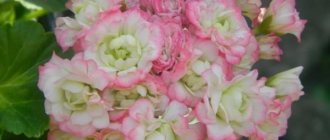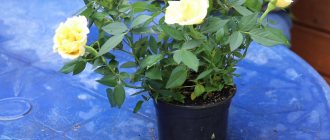Dwarf potted roses: photos and description
The types of roses described below are most suitable for growing indoors.
Chinese rose – Rosa chinensis
Breeders have developed many varieties of dwarf roses for growing as indoor crops.
In the photo you can appreciate the most famous descendants of the Chinese rose (Rosa chinensis):
Among them, “Minima” (red) occupies a special place. They reach from 25 to 40 cm in height and bloom with both double and single flowers of all colors. Miniature potted roses provide color in the summer and drop their leaves in the fall. When a favorable microclimate is created, they bloom earlier and fade later than other species.
Bengal rose – Rosa bengalensis
Ideal for growing in indoor microclimates. The species is unpretentious to conditions and does not require a period of rest, like other potted flowers. This is a small spreading bush that reaches a height of no more than half a meter.
Check out the photo for the variety of dwarf rose “Ophelia” with apricot-pink flowers.
The varieties “Setina” and “Armoza” are characterized by a small number of thorns, abundant flowering and small bush size. The flowers are double, pink, fragrant.
The variety "Baby Carnival" has yellow-red flowers
Pixie 's are white .
Tea rose – Rosa Tea
The plant got its name because of the fragrant smell when flowering. The buds are large, the petals are dense, terry, the spectrum of shades is very diverse - from yellow to red.
Some varieties of this potted rose are characterized by long flowering:
"Nifetos"
"Marshal Niel"
The latter is characterized by a large number of thorns on the stems.
Some hybrid tea forms, for example, “La France,” have large flowers with a diameter of up to 10 cm and a very persistent aroma.
Polyanthus (multifloral) rose – Rosa multiflora nana
Brought out by crossing an ordinary multi-flowered rose and a Chinese rose. Externally, it is a small wide bush up to half a meter high with a highly branched crown. The flowers of this species are small, double or semi-double, odorless. They are often collected in so-called clusters, that is, several flowers on one branch.
As you can see in the photo, potted roses are quite compact, the buds in inflorescences are from 3 to 6 cm in diameter.
Miniature variety reproduces well and tolerates winter well, just like Clotilde .
"Triumph" is distinguished by double bright red flowers, but has practically no scent.
First steps after purchase
When the long-awaited purchase has finally taken place, it is necessary to perform a number of actions to ensure that the rose feels comfortable indoors.
- First, you need to remove the packaging. Because it prevents air from flowing to the plant. Moreover, the development of a fungus is possible.
- it is necessary to trim off dried leaves and buds. To refresh the plant and give it the opportunity to send out fresh shoots.
- If several bushes are planted in a pot, then they must be planted immediately. So that the root system of each does not weaken its blooming neighbor.
- after replanting, the plant must be treated with an antifungal drug.
How to care for a dwarf rose in a pot: watering and fertilizing
This is a light-loving plant, so the bush will feel most comfortable on a windowsill facing east or southeast. The southern direction is dangerous for the flower, especially in summer - the leaves will quickly turn yellow and fall off from excessive amounts of sunlight.
The room in which the rose is located must be well ventilated; stagnant air can provoke the appearance of pests. Many people ask how to care for a dwarf rose if it is not possible to expose it to light. Then it is necessary to turn on the ultraviolet lamp above the flower for at least 3-4 hours a day, otherwise the plant will quickly wither. Otherwise, it is better to wait and not buy a bush.
If you want your flower to be lush, during spring and summer, turn it with different sides towards the light.
From spring to autumn it is necessary to moisten the soil evenly and moderately; in winter, water little, so as not to dry out the earthen lump. The plant loves moisture very much, and without it it can dry out quite quickly. It is necessary to use settled boiled water at room temperature. During the period of active growth from April to September, the plant should be watered as often as the soil dries out quickly. Be careful: the soil should be moist, but without excess water. Caring for a dwarf rose in winter should be different: if the plant enters a dormant period, you need to reduce watering by half.
In summer, the plant can be sprayed with water from a spray bottle every few days.
Roses need a regular supply of nutrients. Without systematic feeding, the condition of the plant deteriorates and it stops blooming. Feeding is needed from March to the end of July every 14 days. It is best to use slow-acting fertilizers - Kemira Universal - one teaspoon every two weeks. In autumn, the best fertilizer is phosphorus and potash fertilizers. In winter, the supply of fertilizers is stopped. Caring for this type of dwarf rose at home will ensure its flowering and long life.
Diseases and pests
Harmful insects often attack this beautiful and fragrant flower. In addition to pests, there is a danger of developing various diseases. Their presence is associated with improper conditions of detention. Therefore, every gardener should know what measures should be taken when certain signs appear.
Why do the leaves turn yellow?
Yellowing of the leaves of a rose indicates an excess of water in the pot. This can be either improper watering or stagnation of moisture in the roots of the plant. In this case, it is important to pay maximum attention to the flower: watering must be reduced and the rose must be allowed to adapt ; only the leaves can be moistened. If the soil is acidic, the bush must be transplanted into new soil.
To strengthen the immunity of yellowed shrubs, use complex fertilizers such as Greenward and Bona Forte.
Leaves are drying
Typically, the leaves of the plant dry out in winter, when the air in the apartment becomes too dry. In summer, during extreme heat, this behavior of the bush is also possible. In addition, the leaves of an indoor rose can dry out for a number of reasons:
- the root system is damaged;
- the soil does not receive enough moisture;
- the pot is located in close proximity to the radiator.
To restore the bush it is necessary to water it and also moisten it with a sprayer . If watering does not produce results, you need to check the roots for damage and, if necessary, separate the cuttings for seedlings.
The leaves are falling
Leaves may fall for several reasons:
- the plant was attacked by pests;
- an indoor rose sheds its leaves if it lacks warmth or there are drafts in the apartment;
- the bush is affected by a fungal or viral infection;
- Cold water was used for irrigation.
If you notice falling leaves on an indoor rose, you should take the following measures:
- damaged leaves are removed;
- inspect the surface of damaged leaves;
- when pests are detected, Fitoverm is used;
- in the presence of diseases (they can be identified by the characteristic mosaic on the leaves), special preparations are used, for example, “Fitosporin”.
White coating on leaves
This sign directly indicates the development of a fungal infection . In addition to plaque, plaques and growths may appear on the bush, and the leaves may become covered with small spots. To cure the plant, you will need to spray it with a solution of Fitosporin.
Why doesn't it bloom?
Sometimes it happens that the bush does not bloom. This is possible for a number of reasons:
- lack of proper fertilizing;
- insufficient lighting;
- the plant has not rested from the previous flowering;
- in case of untimely pruning.
Spider mite
This parasite appears when the air in the room is too dry.
Spider mites entangle the entire bush, sucking nutrients from it. The leaves of the plant turn yellow, wither, and then die. One of the measures to prevent ticks is a warm shower , which should be periodically given to indoor roses, after covering the soil with polyethylene. In difficult cases, this pest is destroyed with an insecticide solution.
As soon as you find a spider mite, the flower pot should be placed in “quarantine” - separately from other plants in the house. Don't forget to inspect the flowers adjacent to it.
Powdery mildew
White coating on the leaves and stems of indoor roses is direct evidence of the appearance of powdery mildew. This disease threatens with blackening of parts of the bush and subsequent death. If the plaque is small, spray the flower with a soda solution (2 teaspoons of soda per 1 liter of water). If the infestation is severe, fungicide treatment will be required.
Aphid
The appearance of aphids occurs when the plant’s immunity is weakened. reducing the high temperature in the room to normal and maintaining the necessary air humidity will come to the rescue
Expert opinion
Vera Ivanovna Sh
Since childhood, I have been interested in growing indoor flowers, then I decided to devote my life to landscape design and gardening.
Spraying the plant against pests with insecticides should be done outdoors in the shade. And only after a day can the pot be returned to its original place, otherwise you risk getting poisoned. Also remember to use gloves and an aspirator.
An indoor rose is perfect as a gift for any occasion. With proper care at home, an indoor rose will retain its attractive appearance, and after a while, new plants can be obtained from the bush. The main thing is not to neglect the rules of care presented in the article.
How to replant a potted rose: tips for replanting the plant
The transplant must be performed almost immediately after purchase. Below are some tips on how to do this correctly. To begin with, the plant needs several days to adapt and get used to its new habitat, and then the soil needs to be changed. The fact is that in stores, plants are often in pots with baking powder or peat, which do not contain useful substances. To prevent the flower from dying due to the proliferation of pathogenic microorganisms in the soil, you need to know how to replant a potted rose.
First you need to remove the flowers from the pot one by one, then rinse the roots under running water, not too cold, but not too hot.
It is important to remove all soil and leave the plant clean. If you find non-woven fabric, it must be carefully removed and removed. To completely remove harmful substances from the flower and ensure its long life and flowering, you can also leave the roots for some time (10-15 minutes) in boiled warm water.
Transplanting potted roses also requires a careful approach to choosing a container. It should be a few centimeters larger in width and height than the purchased one. If you purchase a container that is too large, the plant may not bloom; if it is too small, the root system will have nowhere to develop and the flower will die.
Place drainage at the bottom of the pot in an even layer 1-2 cm thick, and on top - flower soil mixture with fertilizers. Take the plant, plant it in a container and sprinkle it with regular soil. This can be either special soil, which can be purchased at any flower shop, or ordinary moisture-intensive soil.
In addition, you need to know how to care for transplanted dwarf roses in new pots. The plants should stand for one day without watering on the north side of the house. After this, they can be placed in a permanent place, preferably in the south-eastern part of the home. After all, the plant requires a large amount of sun and heat.
Lighting, temperature and humidity
Like garden roses, their dwarf relatives love good lighting, but not the south side, where the bush will quickly bloom and the leaves will fade. Such windows should be shaded in summer, and if possible, the flowerpot should be placed in the southwest. But in winter, when daylight hours are short, the rose needs additional lighting with lamps.
In order for the bush to form evenly, it is recommended to turn it towards the sun as the branches are stretched.
Comfortable temperature for a dwarf rose depends on the time of year and period of development:
- in spring and summer – no higher than 25 degrees Celsius;
- from mid-autumn to the end of winter - from 5 to 8 degrees Celsius.
Dry indoor air is detrimental to roses, so you should spray the bushes daily and place a container of water nearby.
How to care for a potted rose at home in winter, spring, summer and autumn
Most indoor roses have a pronounced dormant period. At this time, buds do not form and the plant withers. In mid-autumn, almost all potted roses shed their leaves for the winter. The exception is the varieties of the Bengal species.
After the plant has completely shed its leaves, it must be placed in a cool place - a glazed balcony or loggia. You can cover it with a jar or wrap the pot in a warm cloth.
In mid-March, the dormant period ends. The rose is brought into a warm room (but not near the radiator!), cut off and replanted in new soil.
Many people have a question: how to properly care for potted roses at home so that they grow buds.
Pruning allows buds to form and stimulates flowering. The procedure must be carried out every year before growth begins, that is, in the spring.
The branches need to be pruned moderately, but if the plant did not survive the winter well, then it is important to carry out radical pruning. Usually half of the shoots are removed, while the weak ones are removed completely.
In summer and autumn, it is necessary to remove faded inflorescences so that the bush creates new ones. Special care is required for the miniature potted rose “Minima”: pruning for it consists only of removing dead or damaged parts of the branches.
Indoor rose diseases
Indoor roses are easy to care for and not capricious, but they are also susceptible to infectious diseases caused by bacteria and fungi. If not properly cared for, other diseases may appear.
Mostly young and weakened plants, as well as those that have been poorly cared for, are susceptible to disease. Common diseases include:
- Powdery mildew - appears when the room is poorly ventilated, plants are crowded in one place, or there is an excess of fertilizers. It is manifested by the appearance of a white coating on the stems and leaves, which then dry out and fall off. It is necessary to remove diseased buds and leaves and treat the bush with fungicides.
- Downy mildew - a white coating affects only the lower layer of leaves, and yellowish spots appear on the upper layer. It is treated by treating the plant with fungicides.
- Rust - manifested by the appearance of brown or red pustules on the back of the leaf. The cause of the disease is improper care; the room was not ventilated, there was excess moisture, the temperature regime was disturbed. Remove the affected leaves and treat with a special fungicide, for example, Topaz.
- Leaf spot is a very common disease, manifested by the appearance of brown spots on the leaves. The cause is infection by fungus or bacteria in a poorly ventilated area with high soil and air humidity, and also if excess stems have not been trimmed. It is treated by treatment with copper-containing or sulfur-containing preparations (Bordeaux mixture, colloidal sulfur). Do not water until complete recovery. Remove diseased leaves and shoots.
You should know exactly how to care for your home rose in order to avoid the occurrence of these diseases. Inspect them more often and apply preventive measures, then there will be no need to take radical measures to treat indoor roses.
Why do indoor miniature roses dry out? Video:
Why do indoor miniature roses dry out? Website "Garden World"
Reproduction of dwarf rose
Regular indoor roses are propagated by cuttings.
This is the propagation of plants using annual green shoots that produce buds. The method is considered the most popular and simple. In order for roots to form in water, propagation is best done during the growth period - in spring or summer. At this time, dwarf roses bloom profusely in pots that are placed on the sunny side.
It is best to take a shoot with a bud, but you can also use a faded branch. From below, a shoot no more than 15 cm long is cut at an angle, from above - straight. In this case, the cutting must have at least two buds, which will subsequently sprout.
The temperature of the water for the cutting should be room temperature, and the liquid must be boiled.
It is advisable that the container for germination be made of dark glass or material, and the container itself should be placed on a windowsill or any other place with plenty of light.
After the roots appear, the cuttings must be transplanted into a small container with soil. Caring for such a home dwarf rose is no different from caring for a regular one. After the first bud appears, the flower can be transplanted into a larger pot.
Appearance
Now the appearance of a hybrid tea rose is as follows: it is a bush or standard tree with long flowering shoots. Each resulting flower is a work of art. Its elongated bud with a sharp tip, opening, reveals numerous satin or velvet petals with neatly curved edges, curled in the center into a high cone. The variety of petal colors and scents is amazing. The flowers are either medium-sized or larger, beautiful, with numerous petals forming a clearly visible central cone. Usually the flowers are single or with several lateral buds.
This may be interesting: Methods for propagating Balsam










